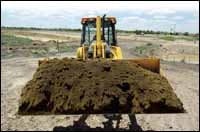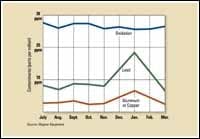Contractors Report Real Backhoe and ADT Life
Even if you're satisfied with the productivity of your backhoe-loaders and articulated dump trucks, the question will inevitably arise: "Are we getting as much life out of components as we should?" If you're not just as happy with the competitiveness of your equipment rates and machine reliability, you may want to compare your experience to some industry averages.
That's why Construction Equipment regularly polls contractors and materials producers to find out how long they expect major components to last. Hopefully the results provide a benchmark for equipment managers to determine how long is "long enough."
But be careful how you use the numbers. An average may seem like middle-of-the-road performance to some, but it can be the upper limit of life expectation for many machines. It depends on how much risk of failure you can afford.
Construction Equipment Lifecycle Research defines a typical range of responses for each component's life expectation. The lower limit of the typical range cuts off the shortest 20 percent of all answers, and the upper limit is set to exclude the largest 20 percent of all responses to the question.
Construction Equipment's 2005 Lifecycle Study found, for example, that 20 percent of engines in 14- to 15-foot backhoe-loaders required major repair or replacement before 6,000 hours. The lower end of the typical range for engine life in 30- to 40-ton articulated dump trucks was 9,000 hours.
In the interest of preventing costly failures, John Deere's discussion of lifecycles in a document titled Component Life Projections suggests the 20-percent hour level is the time for action for machines that are absolutely essential to an operation. If the duty cycle is severe and maintenance practices are not what they should be, it could be the time to overhaul a component, or exchange it with a remanufactured unit. Or downtime may be kept at acceptable levels by simply having an exchange component ready in the event of a failure.
But Deere says that if machine uptime is not so critical and the machines are maintained properly, the median hour level — where 50 percent of components have reached the end of their life — should be the time to prepare for repair. The CE Lifecycle Study indicates that's 8,500 hours for backhoe-loader engines, and 10,000 hours for engines in big ADTs.
Randy Jaminet, manager of customer support in Deere's construction and forestry division, says the median hour level is a good point at which to consider rebuilding or repairing a component before failure. The risk of component failure escalates tremendously once a component passes the age at which half or more of components like it in other applications have failed. As components near the end of their design life, the symptoms of impending failure progress very quickly. They're much more likely to be overlooked.
Variation in operating conditions affects component life enough that Jaminet discourages relying too heavily on industry statistics to schedule maintenance and repair.
"Using oil-analysis trending offers a more accurate indicator of when to remove a component from service because it is based on specific job duty and operating conditions," says Jaminet. "Our component life estimates are a good starting point, but they're not equivalent to oil-analysis trending."
The 2005 Lifecycle Study added an element to help measure the impact of operation severity on component life. The graphs shown with this story include all of the responses for machines in moderate applications. For backhoe-loaders, moderate was defined as "General work with regular cycles in medium to heavy soils. Occasionally using constant-flow attachments. Dig depths to 10 feet." For articulated trucks, moderate is defined as "Infrequent overloading, but some impact loading. Haul roads maintained, but some high rolling resistance and poor traction. Some adverse grades. Typical mass-excavating use."
The survey also allowed users to fill in life experience for machines that work in severe applications. For backhoe-loaders, severe was defined as "Production work or digging in rock. Regular use of constant-flow attachments. Dig depths greater than 10 feet." For ADTs, severe is defined as "Regular overloading. Continuous use on poorly maintained haul roads with high rolling resistance and poor traction. Frequent impact loads and adverse grades."
Backhoe-loaders showed remarkably little difference in engine and transmission life between the two levels of operating severity. Severe applications only shortened average engine and transmission life a few percent.
The difference in work conditions was more obvious in backhoe-loader axle life. Severe applications cut average axle life by nearly 19 percent (1,900 hours) compared to moderate work.
Tire life also shows the strain. Tires wear out in tough working conditions about 19 percent (630 hours) before tires in moderate applications. When asked specifically about the life to puncture, the difference is marked. Tires in severe operations don't make it to 1,000 hours, on average. That's less than 40 percent of the hours to puncture for tires in moderate applications.
The wear and tear of severe applications is more noticeable in articulated dump trucks. Engines and transmissions suffer less than 10 percent reduction in life compared to ADTs in moderate applications. But tires, when punctures are taken out of the numbers, wear out about 20 percent faster.
Like backhoe-loaders, ADTs suffer the rough stuff most at the axles and suspensions. Axle life is cut by nearly 3,600 hours — 20 percent less than in moderate work. Major suspension repairs are necessary in severe applications nearly 3,000 hours sooner — a 31 percent reduction in life. Axles on trucks in severe applications scarcely outlast engines.
The big difference between moderate and severe applications, in terms of overall cost, is a result of the change in the machines' overall endurance. Backhoe-loaders in moderate applications remain in primary production an average of 9,180 hours, while those in severe applications only last about 6,800 hours (26 percent less). ADTs in moderate applications average about 12,960 hours in primary production, while they last just 8,600 hours in severe applications — a drop of 34 percent.
A simple comparison of hourly costs (including ownership costs, fuel, maintenance, and repair parts and labor) for ADTs indicates that machines in severe applications cost 40 percent more per hour to run than those working in moderate conditions. Of course, contractors who work in severe applications understand and adjust for the increased cost of that work.
There's an alternate analysis that could direct a fleet operation to run equipment more cost effectively. A comparison of hourly cost for a common machine that experiences major component failures to that of a machine maintained to prevent breakdowns measures the return on maintenance investments.
Consider the example of two 40-ton articulated trucks working in moderate conditions. Careful maintenance delivers average component lives, and the first truck's components are repaired at average costs. Its residual value is very good, and a simplified accounting of ownership and operating cost over eight years yields just over $65 per hour.
Suppose less-meticulous maintenance allows a catastrophic failure of the transmission and drop box on the second truck. Component life and hours of operation are the same as the first truck, but repair costs for the transmission and drop box skyrocket. Its residual value drops about 10 percent. Hourly cost jumps to $69.10. The second truck costs about $52,300 more than the first over their 13,200-hour lives.
"The key to optimizing the maintenance program is to apply condition-based maintenance," says Jaminet. "That means utilizing oil analysis on a periodic basis consisting of wear metal, oil degradation monitoring, internal and external contaminant ingestion (including water/humidity) and measurement of solid contaminant with particle-count analysis.
"Condition-based maintenance determines the service intervals based on the remaining useful life of the oil. Addressing the root cause for contaminant ingestion before significant component wear occurs will minimize the impact on component life.
"Fuel consumption is a reasonable proxy for the fluid condition," Jaminet adds. "It is relatively easy to record fuel consumption, compared to managing a disciplined oil-analysis program. But maintenance intervals and component replacement guidelines derived from fuel consumption are based on large population averages and, by definition, are not as accurate an indicator of fluid condition and component life as an oil-analysis program can be."




